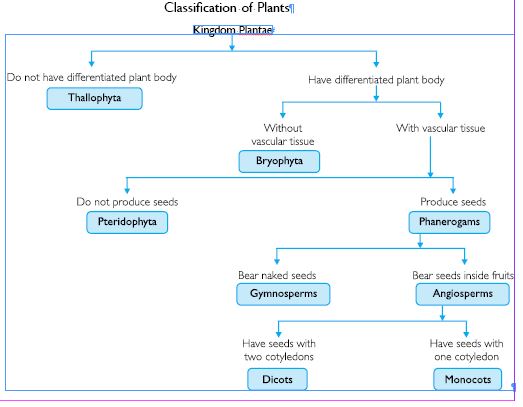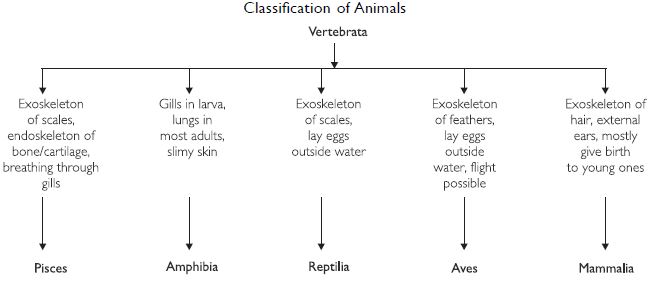Question 1:
Why do we classify organisms?
Answer:
(a) Classification helps in the study of wide variety of organisms in a simple way.
(b) It reveals interrelationship among organisms.
(c) It help in understanding the evolution of organisms.
Question 2:
Give three examples of the range of variations that you see in life forms around you.
Answer:
Different forms in which life occurs on Earth:
(a) Size. Microscopic bacteria—a few micrometres in size to about 30 metres long blue whale
and about 100 metre tall redwood trees of California.
(b) Life Span. Pine trees live for thousands of years while insects such as mosquitoes die
within few days.
(c) Colour. Colourless or transparent worms to brightly coloured birds and flowers.
Question 3:
Which do you think is a more basic characteristic for classifying organisms?
(a) The place where they live.
(b) The kind of cells they are made of. Why?
Answer:
The kind of cells is a more basic characteristic for classification of organisms. The cells may be prokaryotic or eukaryotic. The presence or absence of nucleus, or membrane bound organelles reflect every aspect of cell design and capacity to make a multicellular body.
Question 4:
What is the primary characteristic on which the first division of organism is made?
Answer:
Nature of cell, i.e., if the organism is prokaryotic or eukaryotic.
Question 5:
On what basis are plants and animals put into different categories?
Answer:
(a) Mode of nutrition: Plants prepare their own food by photosynthesis due to the presence of
chlorophyll, while animals depend on other organisms for food.
(b) Presence or absence of cell wall: Plant cells are surrounded by a cell wall, whereas
animal cells lack cell wall.
(c) Mobility: Plants are fixed, whereas animals are motile.
(d) Growth: Plants grow throughout their life, whereas animals stop growing after a certain
period.
Question 6:
Which organisms are called primitive and how are they different from the so called advanced organisms?
Answer:
The organisms which have ancient body designs and have not changed much are called primitive
organisms. They are also called ‘lower’ organisms.
The organisms that have acquired their particular body design relatively recently are called
advanced organisms. They are also called ‘higher’ organisms.
Question 7:
Will advanced organisms be the same as complex organisms? Why?
Answer:
Yes, complexity in design increases over evolutionary time. Hence older (primitive) organisms are simple, while younger (advanced) organisms are more complex. Hence, advanced organisms show greater degree of evolution, which results into more complex organisms.
Question 8:
What is the criterion for classification of organisms as belonging to kingdom Monera or Protista?
Answer:
Nature and number of cell are the criteria for classification of Monera and Protista. Prokaryotes belong to the kingdom Monera, while unicellular eukaryotes belong to the kingdom Protista.
Question 9:
In which kingdom will you place an organism which is single celled, eukaryotic and photosynthetic?
Answer:
Kingdom Protista
Question 10:
In the hierarchy of classification, which grouping will have the smallest number of organisms with maximum of characteristics in common and which will have the largest number of organisms?
Answer:
(a) Species will have smallest number of organisms with maximum characteristics in
common.
(b) Kingdom will have largest number of organisms.
Question 11:
Which division among plants has simplest organisms ?
Answer:
Thallophta in plants has the simplest organisms.
Question 12:
How are pteridophytes different from phanerogams ?
Answer:
Question 13:
How do gymnosperms and angiosperms differ from each other?
Answer:
Differences between gymnosperms and angiosperms:
Question 14:
How do poriferan animals differ from coelenterate animals?
Answer:
Differences between poriferan animals and coelenterate animals:
Question 15:
How do annelid animals differ from arthropods?
Answer:
Differences between annelids and arthropods are:
Question 16:
What are the differences between amphibia and reptilia?
Answer:
Differences between amphibia and reptilia are:
Question 17:
What are the differences between animals belonging to the Aves group and those in the Mammalia group?
Answer:
Differences between aves and mammals are:
Question 18:
What are the advantages of classifying organisms?
Answer:
Advantages of classification
Note: Refer to Question 1 of Page - 80 NCERT IN-TEXT QUESTIONS
Question 19:
How would you choose between two characteristics to be used for developing a hierarchy in classification?
Answer:
Characteristic is a particular form or function. Many inter-related characteristics are used to classify all living organisms. Gross characters form the basis of the beginning of a hierarchy, while fine characters form the basis of further steps of the hierarchy.
Question 20:
Explain the basis for grouping organisms into five kingdoms.
Answer:
Five kingdom system of classification was proposed by Whittaker and is based on:
1. Nature of cells: Prokaryotic or eukaryotic.
2. Number of cells: Unicellular or multicellular.
3. Mode of nutrition: Absorptive, autotrophic or holozoic.
4. Phylogenetic relationship: The evolutionary history or ancestry of an organism.
Question 21:
What are the major divisions in Plantae? What is the basis for these divisions?
Answer:
Major divisions of kingdom Plantae are illustrated below:
Question 22:
How are the criteria for deciding divisions in plants different from the criteria for deciding the subgroups among animals?
Answer:
Criteria for dividing plants: The eukaryotic multicellular organisms having a cell wall and
carrying out photosynthesis are placed under the kingdom Plantae.
The first level of classification among plants depends on whether the plant body has
well-differentiated, distinct components. The next level of classification is based on
whether the differentiated plant body has special tissues for the transport of water and
other substances within it. Further classification looks at the ability to bear seeds and
whether the seeds are enclosed within fruits.
Criteria for dividing animals: The eukaryotic multicellular heterotrophs, lacking cell wall
are placed in the kingdom Animalia. They are further classified on the basis of the extent
and type of body design and differentiation present.
Question 23:
Explain how animals in Vertebrata are classified into further sub-groups.








